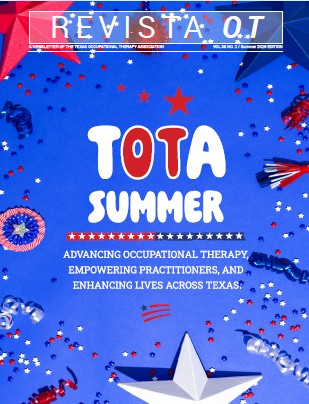|
What is occupational therapy?
Occupational therapy is a method of treatment that uses purposeful occupations, those things that we do everyday in life, to return individuals with disability to function. The American Occupational Therapy Association has a motto that expresses OT well: OT: Living Life to the fullest
What do occupational therapy practitioners do?
Occupational therapists and occupational therapy assistants (occupational therapy practitioners) work with individuals who have been disabled by injury, illness, disease processes, developmental delay, or through the aging process. Disabilities can be physical or mental. Occupational therapy practitioners work with a variety of patients throughout the age spectrum. In the past, occupational therapy has been ordered through a physician. However, thanks to our efforts in the 1999 Texas Legislative Session, OTs may now accept referrals from a licensed referral source (refer to
the Occupational Therapy Practice Act §454.213.
Early intervention programs, schools, work sites, and other community sites like sheltered workshops or adult day care may access occupational therapy. These programs may have some other decision-making committee or body that helps determine the need for OT services. Many third party payors may require a physician referral, but it is not a legal requirement if their condition is static.
Here are some examples of the broad spectrum of OT care:
Through occupational therapy older adults learn to:
- Adapt to changes brought about by aging, such as decreased energy and vision
- Safely perform routine activities such as dressing and cooking
- Increase physical strength and endurance to maintain self-sufficiency
- Identify community resources such as senior centers and stoke clubs
- Cope with the losses of aging such as the death of a spouse or friend
- Adapt the home for safety and efficiency
- Recognize and counteract depression
Occupational therapy is important for children with:
- Developmental delay
- Muscular dystrophy
- Developmental disabilities, including intellectual disability, spina bifida, and cerebral palsy
- Sensory integrative dysfunction and sensory processing disorders
- Juvenile rheumatoid arthritis and related disorders
- Learning disabilities, including dyslexia
- Delayed or impaired motor development
- Orthopedic disabilities, traumatic injuries, burn, and amputations
- Emotional disturbances, behavioral problems, autism, and attention deficit disorders
Occupational therapy is important for adults with problems related to:
- Work injuries, including amputation, hand trauma, and burns
- Cardiovascular disease, including myocardial infarction and peripheral vascular diseases
- Mental health problems, including stress reactions, drug and alcohol abuse, depression, schizophrenia, and bipolar disorders
- Neurological dysfunction, including brain tumors, multiple sclerosis, stroke, and neuropathy
- Terminal illnesses and palliative care
- Cancer including breast, head and neck
The Bureau of Labor Statistics has an excellent and comprehensive explanation of what OT is and what OT practitioners do. This includes projections about the future of the profession and salary information.
What is the required education and training?
The occupational therapist must graduate from an accredited program and complete a minimum of 6 months of supervised clinical experience.
The occupational therapy assistant completes an accredited program and at least 12 weeks of supervised fieldwork experience.
Following the completion of course and clinical work, the therapist or assistant must pass a national certification examination to become a designated occupational therapist or occupational therapy assistant. In addition, states regulate occupational therapy through licensure and continuing educational requirements. Foreign educated practitioners applying to work as an occupational therapist in the United States should contact [email protected] for eligibility requirements.
Currently accredited OTD programs
Currently accredited Masters of OT programs
Currently accredited OTA programs
Where do occupational therapy practitioners practice?
Occupational therapists may be employed in various settings. Many are in general and rehabilitation hospitals, medical offices, clinics, public and private schools, nursing homes, mental health centers, community centers, and in home health.
How much do occupational therapy practitioners make?
See the above-referenced Bureau of Labor Statistics web page regarding occupational therapy. Additionally, there are several helpful salary resources listed on the additional links (members only) of this web site.
Does TOTA issue licenses for OTRs and COTAs?
No. Occupational therapy licenses are issued by the Texas Board of OT Examiners (TBOTE). TBOTE is a state agency and all OT professionals must be licensed to practice in Texas. For further information about obtaining or renewing (or any information about licensure) in Texas, contact TBOTE: Phone 512-305-6900
Is continuing education required in Texas?
Yes. Twenty-four (24) hours of continuing education are required every two years to maintain licensure in Texas. Please review the the Texas Board of OT Examiners' website for a complete list of the rules.
How can I contact TOTA?
The address and phone are at the bottom of this page.
What does TOTA do?
For a list of membership benefits, see Membership.
|


